Comprehensive Strategic Management Report: Woolworths Group Analysis
VerifiedAdded on 2020/10/05
|11
|2986
|400
Report
AI Summary
This report provides a comprehensive analysis of the strategic management of Woolworths Group. It begins with an executive summary outlining the key strategies employed by the company to achieve competitive advantage, including cost differentiation and pricing strategies. The report then delves into an evaluation of Woolworths' organizational environment, utilizing Porter's Five Forces and PESTLE analysis to assess external factors such as political and economic influences. Internal analysis, including core competencies and value chain analysis, is also conducted. The report examines Woolworths' competitive advantages, focusing on its rivalry with competitors like Coles, Aldi, and Costco. The strategic formulation section details Woolworths' vision, goals, and strategic choices, including cost leadership versus differentiation. Finally, the report offers recommendations, supporting the differentiation strategy and critiquing its potential challenges, concluding with an assessment of the company's overall strategic approach.
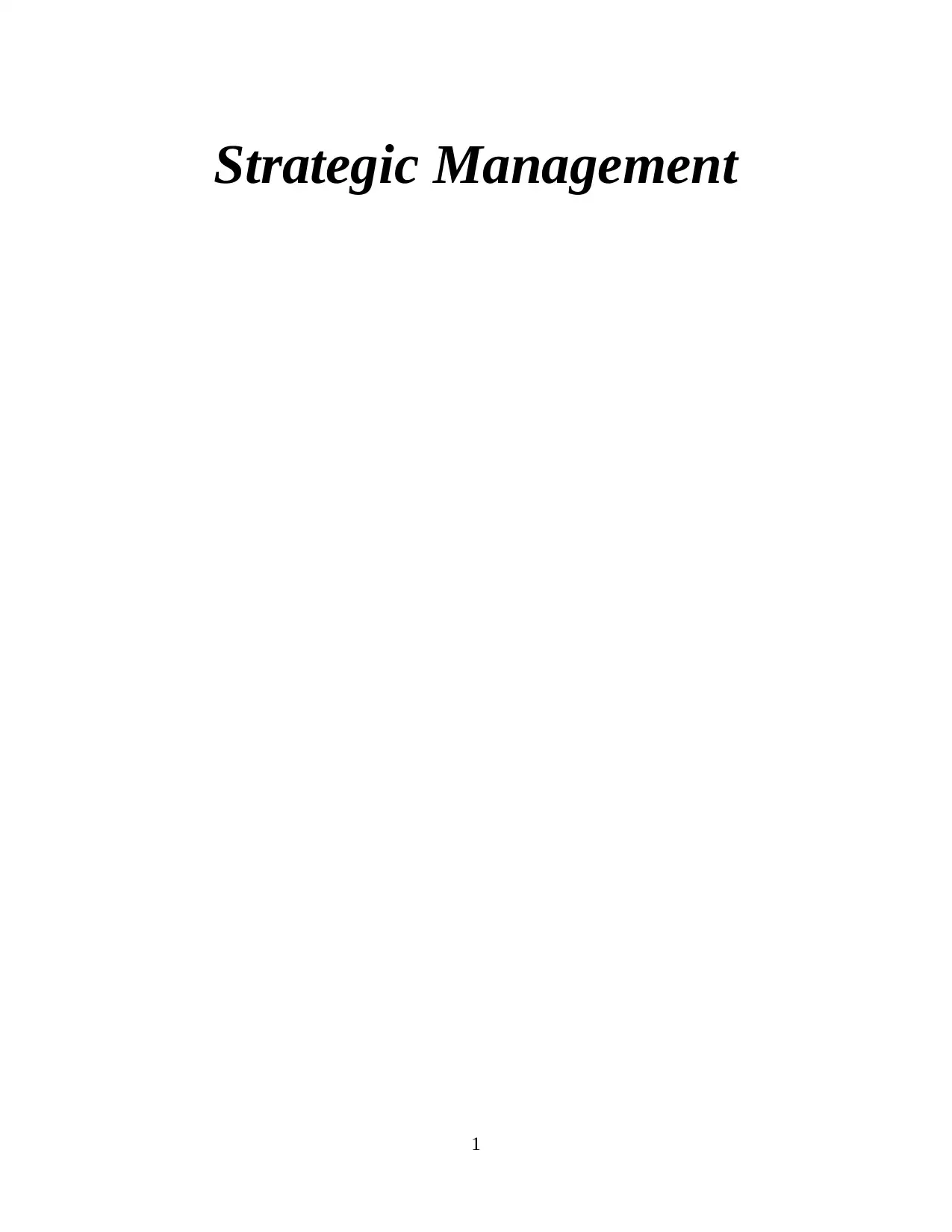
Strategic Management
1
1
Paraphrase This Document
Need a fresh take? Get an instant paraphrase of this document with our AI Paraphraser
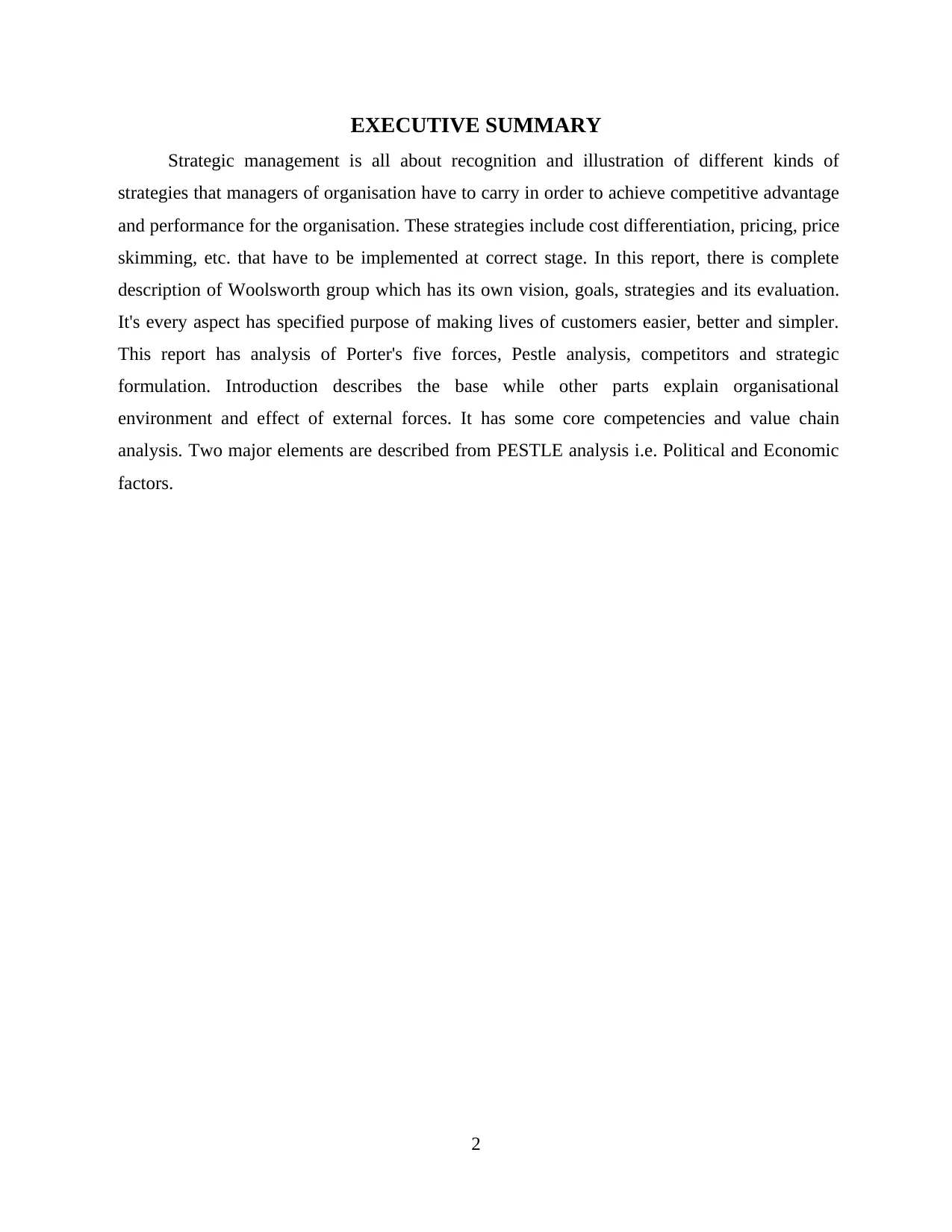
EXECUTIVE SUMMARY
Strategic management is all about recognition and illustration of different kinds of
strategies that managers of organisation have to carry in order to achieve competitive advantage
and performance for the organisation. These strategies include cost differentiation, pricing, price
skimming, etc. that have to be implemented at correct stage. In this report, there is complete
description of Woolsworth group which has its own vision, goals, strategies and its evaluation.
It's every aspect has specified purpose of making lives of customers easier, better and simpler.
This report has analysis of Porter's five forces, Pestle analysis, competitors and strategic
formulation. Introduction describes the base while other parts explain organisational
environment and effect of external forces. It has some core competencies and value chain
analysis. Two major elements are described from PESTLE analysis i.e. Political and Economic
factors.
2
Strategic management is all about recognition and illustration of different kinds of
strategies that managers of organisation have to carry in order to achieve competitive advantage
and performance for the organisation. These strategies include cost differentiation, pricing, price
skimming, etc. that have to be implemented at correct stage. In this report, there is complete
description of Woolsworth group which has its own vision, goals, strategies and its evaluation.
It's every aspect has specified purpose of making lives of customers easier, better and simpler.
This report has analysis of Porter's five forces, Pestle analysis, competitors and strategic
formulation. Introduction describes the base while other parts explain organisational
environment and effect of external forces. It has some core competencies and value chain
analysis. Two major elements are described from PESTLE analysis i.e. Political and Economic
factors.
2
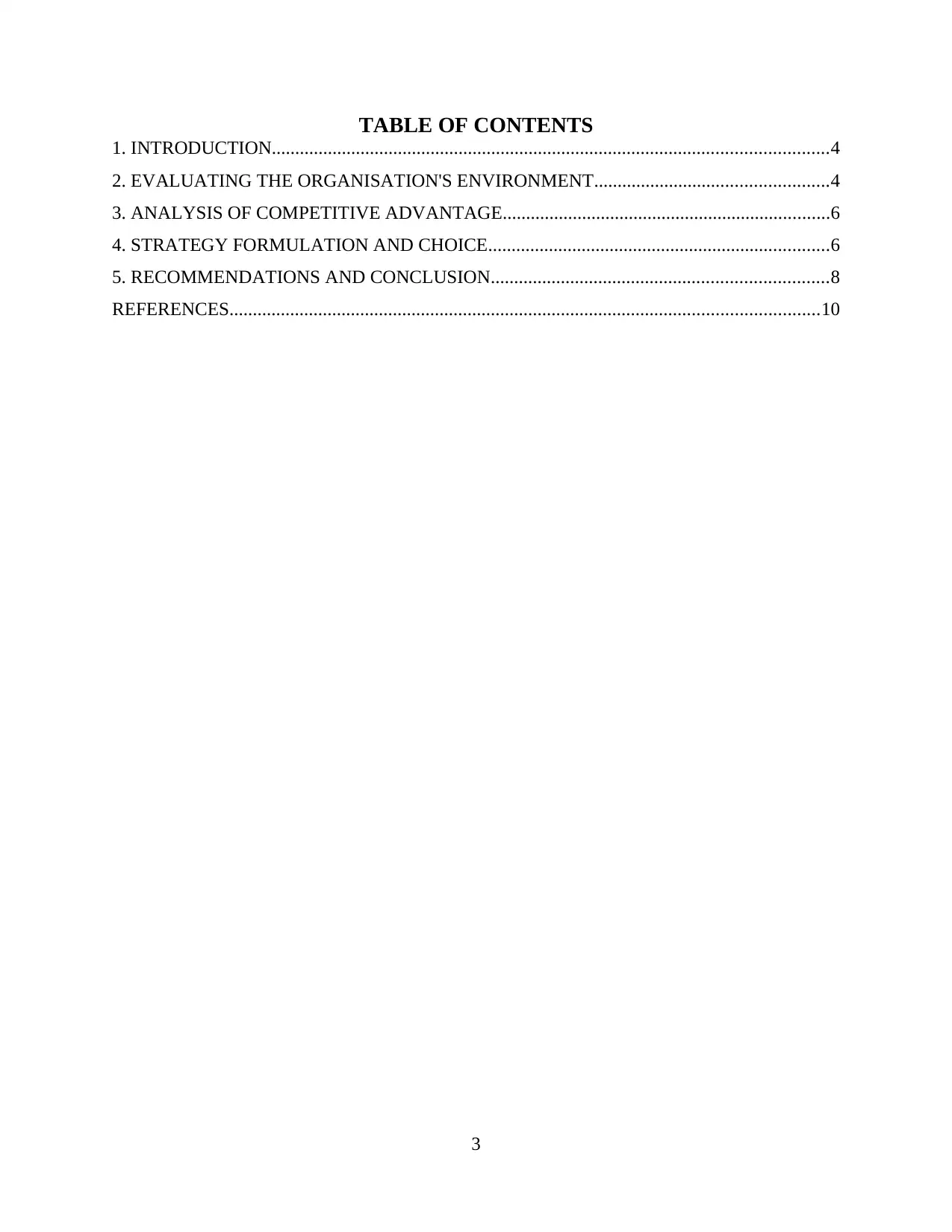
TABLE OF CONTENTS
1. INTRODUCTION.......................................................................................................................4
2. EVALUATING THE ORGANISATION'S ENVIRONMENT..................................................4
3. ANALYSIS OF COMPETITIVE ADVANTAGE......................................................................6
4. STRATEGY FORMULATION AND CHOICE.........................................................................6
5. RECOMMENDATIONS AND CONCLUSION........................................................................8
REFERENCES..............................................................................................................................10
3
1. INTRODUCTION.......................................................................................................................4
2. EVALUATING THE ORGANISATION'S ENVIRONMENT..................................................4
3. ANALYSIS OF COMPETITIVE ADVANTAGE......................................................................6
4. STRATEGY FORMULATION AND CHOICE.........................................................................6
5. RECOMMENDATIONS AND CONCLUSION........................................................................8
REFERENCES..............................................................................................................................10
3
⊘ This is a preview!⊘
Do you want full access?
Subscribe today to unlock all pages.

Trusted by 1+ million students worldwide
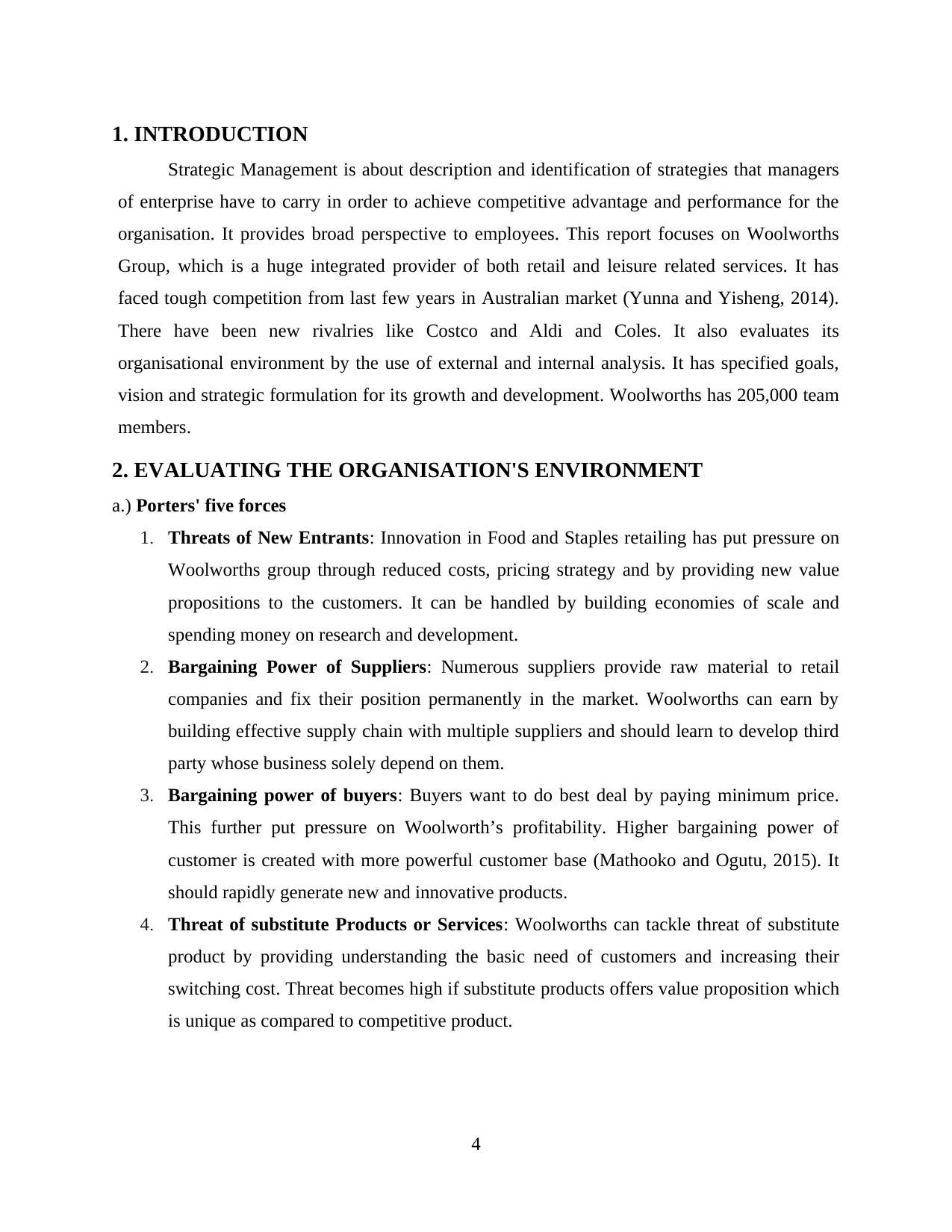
1. INTRODUCTION
Strategic Management is about description and identification of strategies that managers
of enterprise have to carry in order to achieve competitive advantage and performance for the
organisation. It provides broad perspective to employees. This report focuses on Woolworths
Group, which is a huge integrated provider of both retail and leisure related services. It has
faced tough competition from last few years in Australian market (Yunna and Yisheng, 2014).
There have been new rivalries like Costco and Aldi and Coles. It also evaluates its
organisational environment by the use of external and internal analysis. It has specified goals,
vision and strategic formulation for its growth and development. Woolworths has 205,000 team
members.
2. EVALUATING THE ORGANISATION'S ENVIRONMENT
a.) Porters' five forces
1. Threats of New Entrants: Innovation in Food and Staples retailing has put pressure on
Woolworths group through reduced costs, pricing strategy and by providing new value
propositions to the customers. It can be handled by building economies of scale and
spending money on research and development.
2. Bargaining Power of Suppliers: Numerous suppliers provide raw material to retail
companies and fix their position permanently in the market. Woolworths can earn by
building effective supply chain with multiple suppliers and should learn to develop third
party whose business solely depend on them.
3. Bargaining power of buyers: Buyers want to do best deal by paying minimum price.
This further put pressure on Woolworth’s profitability. Higher bargaining power of
customer is created with more powerful customer base (Mathooko and Ogutu, 2015). It
should rapidly generate new and innovative products.
4. Threat of substitute Products or Services: Woolworths can tackle threat of substitute
product by providing understanding the basic need of customers and increasing their
switching cost. Threat becomes high if substitute products offers value proposition which
is unique as compared to competitive product.
4
Strategic Management is about description and identification of strategies that managers
of enterprise have to carry in order to achieve competitive advantage and performance for the
organisation. It provides broad perspective to employees. This report focuses on Woolworths
Group, which is a huge integrated provider of both retail and leisure related services. It has
faced tough competition from last few years in Australian market (Yunna and Yisheng, 2014).
There have been new rivalries like Costco and Aldi and Coles. It also evaluates its
organisational environment by the use of external and internal analysis. It has specified goals,
vision and strategic formulation for its growth and development. Woolworths has 205,000 team
members.
2. EVALUATING THE ORGANISATION'S ENVIRONMENT
a.) Porters' five forces
1. Threats of New Entrants: Innovation in Food and Staples retailing has put pressure on
Woolworths group through reduced costs, pricing strategy and by providing new value
propositions to the customers. It can be handled by building economies of scale and
spending money on research and development.
2. Bargaining Power of Suppliers: Numerous suppliers provide raw material to retail
companies and fix their position permanently in the market. Woolworths can earn by
building effective supply chain with multiple suppliers and should learn to develop third
party whose business solely depend on them.
3. Bargaining power of buyers: Buyers want to do best deal by paying minimum price.
This further put pressure on Woolworth’s profitability. Higher bargaining power of
customer is created with more powerful customer base (Mathooko and Ogutu, 2015). It
should rapidly generate new and innovative products.
4. Threat of substitute Products or Services: Woolworths can tackle threat of substitute
product by providing understanding the basic need of customers and increasing their
switching cost. Threat becomes high if substitute products offers value proposition which
is unique as compared to competitive product.
4
Paraphrase This Document
Need a fresh take? Get an instant paraphrase of this document with our AI Paraphraser
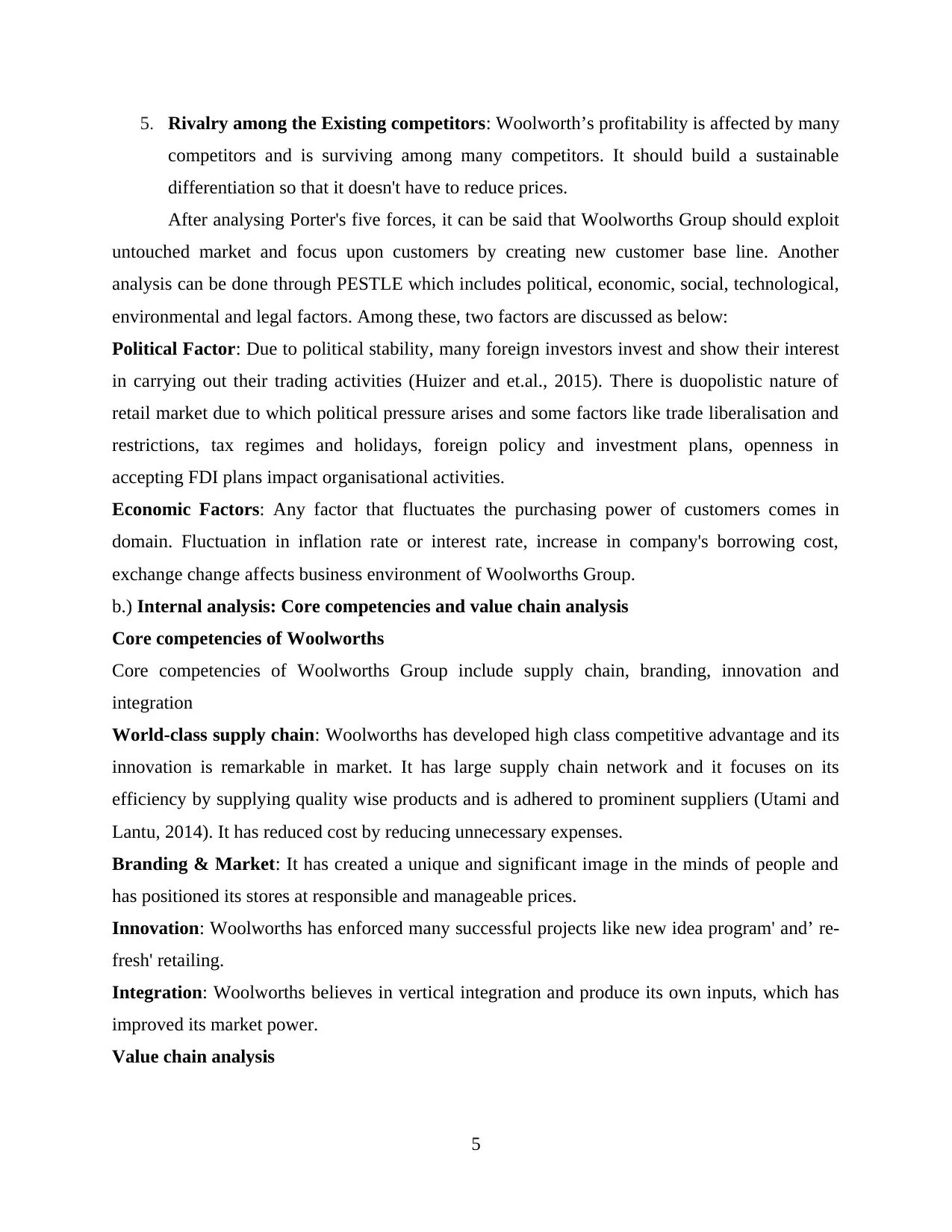
5. Rivalry among the Existing competitors: Woolworth’s profitability is affected by many
competitors and is surviving among many competitors. It should build a sustainable
differentiation so that it doesn't have to reduce prices.
After analysing Porter's five forces, it can be said that Woolworths Group should exploit
untouched market and focus upon customers by creating new customer base line. Another
analysis can be done through PESTLE which includes political, economic, social, technological,
environmental and legal factors. Among these, two factors are discussed as below:
Political Factor: Due to political stability, many foreign investors invest and show their interest
in carrying out their trading activities (Huizer and et.al., 2015). There is duopolistic nature of
retail market due to which political pressure arises and some factors like trade liberalisation and
restrictions, tax regimes and holidays, foreign policy and investment plans, openness in
accepting FDI plans impact organisational activities.
Economic Factors: Any factor that fluctuates the purchasing power of customers comes in
domain. Fluctuation in inflation rate or interest rate, increase in company's borrowing cost,
exchange change affects business environment of Woolworths Group.
b.) Internal analysis: Core competencies and value chain analysis
Core competencies of Woolworths
Core competencies of Woolworths Group include supply chain, branding, innovation and
integration
World-class supply chain: Woolworths has developed high class competitive advantage and its
innovation is remarkable in market. It has large supply chain network and it focuses on its
efficiency by supplying quality wise products and is adhered to prominent suppliers (Utami and
Lantu, 2014). It has reduced cost by reducing unnecessary expenses.
Branding & Market: It has created a unique and significant image in the minds of people and
has positioned its stores at responsible and manageable prices.
Innovation: Woolworths has enforced many successful projects like new idea program' and’ re-
fresh' retailing.
Integration: Woolworths believes in vertical integration and produce its own inputs, which has
improved its market power.
Value chain analysis
5
competitors and is surviving among many competitors. It should build a sustainable
differentiation so that it doesn't have to reduce prices.
After analysing Porter's five forces, it can be said that Woolworths Group should exploit
untouched market and focus upon customers by creating new customer base line. Another
analysis can be done through PESTLE which includes political, economic, social, technological,
environmental and legal factors. Among these, two factors are discussed as below:
Political Factor: Due to political stability, many foreign investors invest and show their interest
in carrying out their trading activities (Huizer and et.al., 2015). There is duopolistic nature of
retail market due to which political pressure arises and some factors like trade liberalisation and
restrictions, tax regimes and holidays, foreign policy and investment plans, openness in
accepting FDI plans impact organisational activities.
Economic Factors: Any factor that fluctuates the purchasing power of customers comes in
domain. Fluctuation in inflation rate or interest rate, increase in company's borrowing cost,
exchange change affects business environment of Woolworths Group.
b.) Internal analysis: Core competencies and value chain analysis
Core competencies of Woolworths
Core competencies of Woolworths Group include supply chain, branding, innovation and
integration
World-class supply chain: Woolworths has developed high class competitive advantage and its
innovation is remarkable in market. It has large supply chain network and it focuses on its
efficiency by supplying quality wise products and is adhered to prominent suppliers (Utami and
Lantu, 2014). It has reduced cost by reducing unnecessary expenses.
Branding & Market: It has created a unique and significant image in the minds of people and
has positioned its stores at responsible and manageable prices.
Innovation: Woolworths has enforced many successful projects like new idea program' and’ re-
fresh' retailing.
Integration: Woolworths believes in vertical integration and produce its own inputs, which has
improved its market power.
Value chain analysis
5
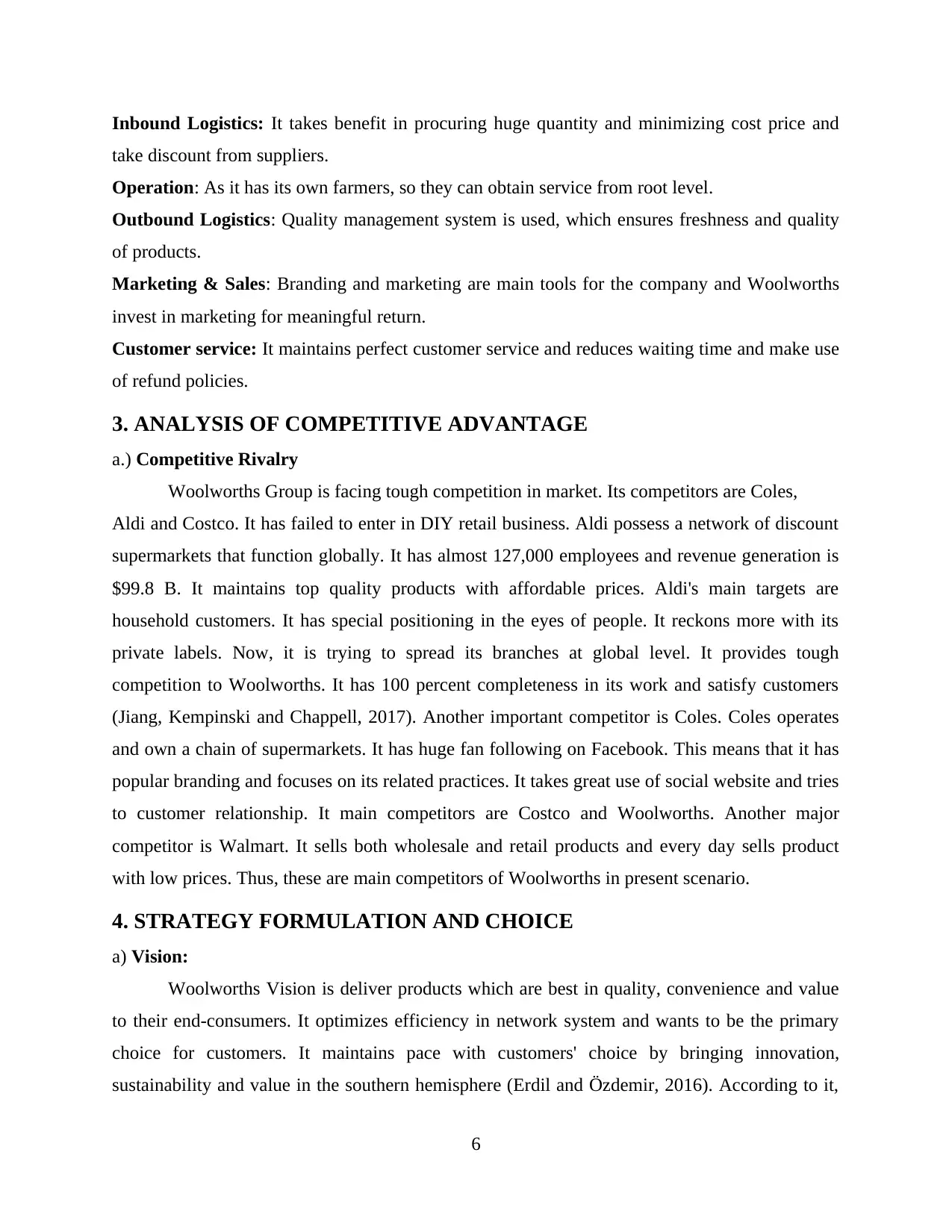
Inbound Logistics: It takes benefit in procuring huge quantity and minimizing cost price and
take discount from suppliers.
Operation: As it has its own farmers, so they can obtain service from root level.
Outbound Logistics: Quality management system is used, which ensures freshness and quality
of products.
Marketing & Sales: Branding and marketing are main tools for the company and Woolworths
invest in marketing for meaningful return.
Customer service: It maintains perfect customer service and reduces waiting time and make use
of refund policies.
3. ANALYSIS OF COMPETITIVE ADVANTAGE
a.) Competitive Rivalry
Woolworths Group is facing tough competition in market. Its competitors are Coles,
Aldi and Costco. It has failed to enter in DIY retail business. Aldi possess a network of discount
supermarkets that function globally. It has almost 127,000 employees and revenue generation is
$99.8 B. It maintains top quality products with affordable prices. Aldi's main targets are
household customers. It has special positioning in the eyes of people. It reckons more with its
private labels. Now, it is trying to spread its branches at global level. It provides tough
competition to Woolworths. It has 100 percent completeness in its work and satisfy customers
(Jiang, Kempinski and Chappell, 2017). Another important competitor is Coles. Coles operates
and own a chain of supermarkets. It has huge fan following on Facebook. This means that it has
popular branding and focuses on its related practices. It takes great use of social website and tries
to customer relationship. It main competitors are Costco and Woolworths. Another major
competitor is Walmart. It sells both wholesale and retail products and every day sells product
with low prices. Thus, these are main competitors of Woolworths in present scenario.
4. STRATEGY FORMULATION AND CHOICE
a) Vision:
Woolworths Vision is deliver products which are best in quality, convenience and value
to their end-consumers. It optimizes efficiency in network system and wants to be the primary
choice for customers. It maintains pace with customers' choice by bringing innovation,
sustainability and value in the southern hemisphere (Erdil and Özdemir, 2016). According to it,
6
take discount from suppliers.
Operation: As it has its own farmers, so they can obtain service from root level.
Outbound Logistics: Quality management system is used, which ensures freshness and quality
of products.
Marketing & Sales: Branding and marketing are main tools for the company and Woolworths
invest in marketing for meaningful return.
Customer service: It maintains perfect customer service and reduces waiting time and make use
of refund policies.
3. ANALYSIS OF COMPETITIVE ADVANTAGE
a.) Competitive Rivalry
Woolworths Group is facing tough competition in market. Its competitors are Coles,
Aldi and Costco. It has failed to enter in DIY retail business. Aldi possess a network of discount
supermarkets that function globally. It has almost 127,000 employees and revenue generation is
$99.8 B. It maintains top quality products with affordable prices. Aldi's main targets are
household customers. It has special positioning in the eyes of people. It reckons more with its
private labels. Now, it is trying to spread its branches at global level. It provides tough
competition to Woolworths. It has 100 percent completeness in its work and satisfy customers
(Jiang, Kempinski and Chappell, 2017). Another important competitor is Coles. Coles operates
and own a chain of supermarkets. It has huge fan following on Facebook. This means that it has
popular branding and focuses on its related practices. It takes great use of social website and tries
to customer relationship. It main competitors are Costco and Woolworths. Another major
competitor is Walmart. It sells both wholesale and retail products and every day sells product
with low prices. Thus, these are main competitors of Woolworths in present scenario.
4. STRATEGY FORMULATION AND CHOICE
a) Vision:
Woolworths Vision is deliver products which are best in quality, convenience and value
to their end-consumers. It optimizes efficiency in network system and wants to be the primary
choice for customers. It maintains pace with customers' choice by bringing innovation,
sustainability and value in the southern hemisphere (Erdil and Özdemir, 2016). According to it,
6
⊘ This is a preview!⊘
Do you want full access?
Subscribe today to unlock all pages.

Trusted by 1+ million students worldwide
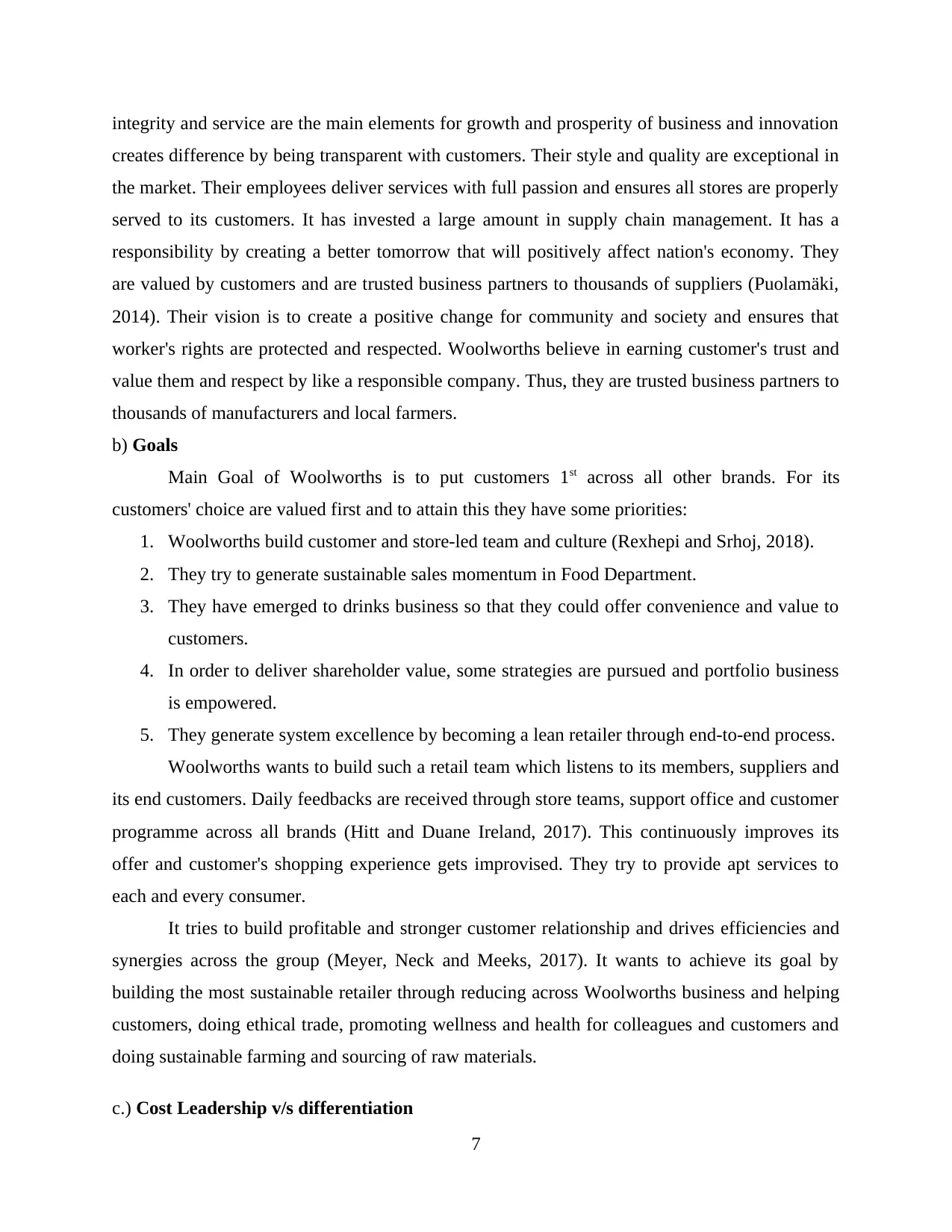
integrity and service are the main elements for growth and prosperity of business and innovation
creates difference by being transparent with customers. Their style and quality are exceptional in
the market. Their employees deliver services with full passion and ensures all stores are properly
served to its customers. It has invested a large amount in supply chain management. It has a
responsibility by creating a better tomorrow that will positively affect nation's economy. They
are valued by customers and are trusted business partners to thousands of suppliers (Puolamäki,
2014). Their vision is to create a positive change for community and society and ensures that
worker's rights are protected and respected. Woolworths believe in earning customer's trust and
value them and respect by like a responsible company. Thus, they are trusted business partners to
thousands of manufacturers and local farmers.
b) Goals
Main Goal of Woolworths is to put customers 1st across all other brands. For its
customers' choice are valued first and to attain this they have some priorities:
1. Woolworths build customer and store-led team and culture (Rexhepi and Srhoj, 2018).
2. They try to generate sustainable sales momentum in Food Department.
3. They have emerged to drinks business so that they could offer convenience and value to
customers.
4. In order to deliver shareholder value, some strategies are pursued and portfolio business
is empowered.
5. They generate system excellence by becoming a lean retailer through end-to-end process.
Woolworths wants to build such a retail team which listens to its members, suppliers and
its end customers. Daily feedbacks are received through store teams, support office and customer
programme across all brands (Hitt and Duane Ireland, 2017). This continuously improves its
offer and customer's shopping experience gets improvised. They try to provide apt services to
each and every consumer.
It tries to build profitable and stronger customer relationship and drives efficiencies and
synergies across the group (Meyer, Neck and Meeks, 2017). It wants to achieve its goal by
building the most sustainable retailer through reducing across Woolworths business and helping
customers, doing ethical trade, promoting wellness and health for colleagues and customers and
doing sustainable farming and sourcing of raw materials.
c.) Cost Leadership v/s differentiation
7
creates difference by being transparent with customers. Their style and quality are exceptional in
the market. Their employees deliver services with full passion and ensures all stores are properly
served to its customers. It has invested a large amount in supply chain management. It has a
responsibility by creating a better tomorrow that will positively affect nation's economy. They
are valued by customers and are trusted business partners to thousands of suppliers (Puolamäki,
2014). Their vision is to create a positive change for community and society and ensures that
worker's rights are protected and respected. Woolworths believe in earning customer's trust and
value them and respect by like a responsible company. Thus, they are trusted business partners to
thousands of manufacturers and local farmers.
b) Goals
Main Goal of Woolworths is to put customers 1st across all other brands. For its
customers' choice are valued first and to attain this they have some priorities:
1. Woolworths build customer and store-led team and culture (Rexhepi and Srhoj, 2018).
2. They try to generate sustainable sales momentum in Food Department.
3. They have emerged to drinks business so that they could offer convenience and value to
customers.
4. In order to deliver shareholder value, some strategies are pursued and portfolio business
is empowered.
5. They generate system excellence by becoming a lean retailer through end-to-end process.
Woolworths wants to build such a retail team which listens to its members, suppliers and
its end customers. Daily feedbacks are received through store teams, support office and customer
programme across all brands (Hitt and Duane Ireland, 2017). This continuously improves its
offer and customer's shopping experience gets improvised. They try to provide apt services to
each and every consumer.
It tries to build profitable and stronger customer relationship and drives efficiencies and
synergies across the group (Meyer, Neck and Meeks, 2017). It wants to achieve its goal by
building the most sustainable retailer through reducing across Woolworths business and helping
customers, doing ethical trade, promoting wellness and health for colleagues and customers and
doing sustainable farming and sourcing of raw materials.
c.) Cost Leadership v/s differentiation
7
Paraphrase This Document
Need a fresh take? Get an instant paraphrase of this document with our AI Paraphraser
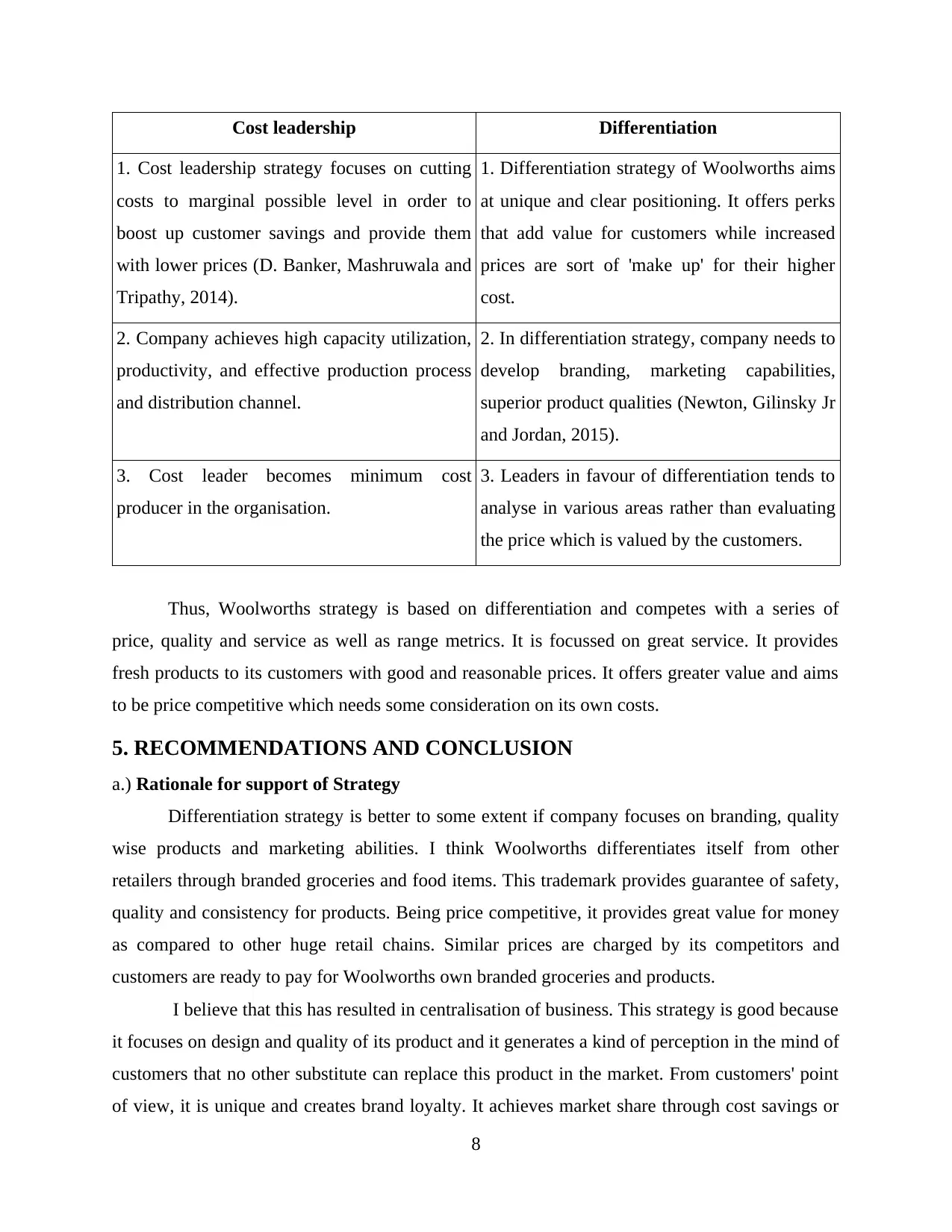
Cost leadership Differentiation
1. Cost leadership strategy focuses on cutting
costs to marginal possible level in order to
boost up customer savings and provide them
with lower prices (D. Banker, Mashruwala and
Tripathy, 2014).
1. Differentiation strategy of Woolworths aims
at unique and clear positioning. It offers perks
that add value for customers while increased
prices are sort of 'make up' for their higher
cost.
2. Company achieves high capacity utilization,
productivity, and effective production process
and distribution channel.
2. In differentiation strategy, company needs to
develop branding, marketing capabilities,
superior product qualities (Newton, Gilinsky Jr
and Jordan, 2015).
3. Cost leader becomes minimum cost
producer in the organisation.
3. Leaders in favour of differentiation tends to
analyse in various areas rather than evaluating
the price which is valued by the customers.
Thus, Woolworths strategy is based on differentiation and competes with a series of
price, quality and service as well as range metrics. It is focussed on great service. It provides
fresh products to its customers with good and reasonable prices. It offers greater value and aims
to be price competitive which needs some consideration on its own costs.
5. RECOMMENDATIONS AND CONCLUSION
a.) Rationale for support of Strategy
Differentiation strategy is better to some extent if company focuses on branding, quality
wise products and marketing abilities. I think Woolworths differentiates itself from other
retailers through branded groceries and food items. This trademark provides guarantee of safety,
quality and consistency for products. Being price competitive, it provides great value for money
as compared to other huge retail chains. Similar prices are charged by its competitors and
customers are ready to pay for Woolworths own branded groceries and products.
I believe that this has resulted in centralisation of business. This strategy is good because
it focuses on design and quality of its product and it generates a kind of perception in the mind of
customers that no other substitute can replace this product in the market. From customers' point
of view, it is unique and creates brand loyalty. It achieves market share through cost savings or
8
1. Cost leadership strategy focuses on cutting
costs to marginal possible level in order to
boost up customer savings and provide them
with lower prices (D. Banker, Mashruwala and
Tripathy, 2014).
1. Differentiation strategy of Woolworths aims
at unique and clear positioning. It offers perks
that add value for customers while increased
prices are sort of 'make up' for their higher
cost.
2. Company achieves high capacity utilization,
productivity, and effective production process
and distribution channel.
2. In differentiation strategy, company needs to
develop branding, marketing capabilities,
superior product qualities (Newton, Gilinsky Jr
and Jordan, 2015).
3. Cost leader becomes minimum cost
producer in the organisation.
3. Leaders in favour of differentiation tends to
analyse in various areas rather than evaluating
the price which is valued by the customers.
Thus, Woolworths strategy is based on differentiation and competes with a series of
price, quality and service as well as range metrics. It is focussed on great service. It provides
fresh products to its customers with good and reasonable prices. It offers greater value and aims
to be price competitive which needs some consideration on its own costs.
5. RECOMMENDATIONS AND CONCLUSION
a.) Rationale for support of Strategy
Differentiation strategy is better to some extent if company focuses on branding, quality
wise products and marketing abilities. I think Woolworths differentiates itself from other
retailers through branded groceries and food items. This trademark provides guarantee of safety,
quality and consistency for products. Being price competitive, it provides great value for money
as compared to other huge retail chains. Similar prices are charged by its competitors and
customers are ready to pay for Woolworths own branded groceries and products.
I believe that this has resulted in centralisation of business. This strategy is good because
it focuses on design and quality of its product and it generates a kind of perception in the mind of
customers that no other substitute can replace this product in the market. From customers' point
of view, it is unique and creates brand loyalty. It achieves market share through cost savings or
8
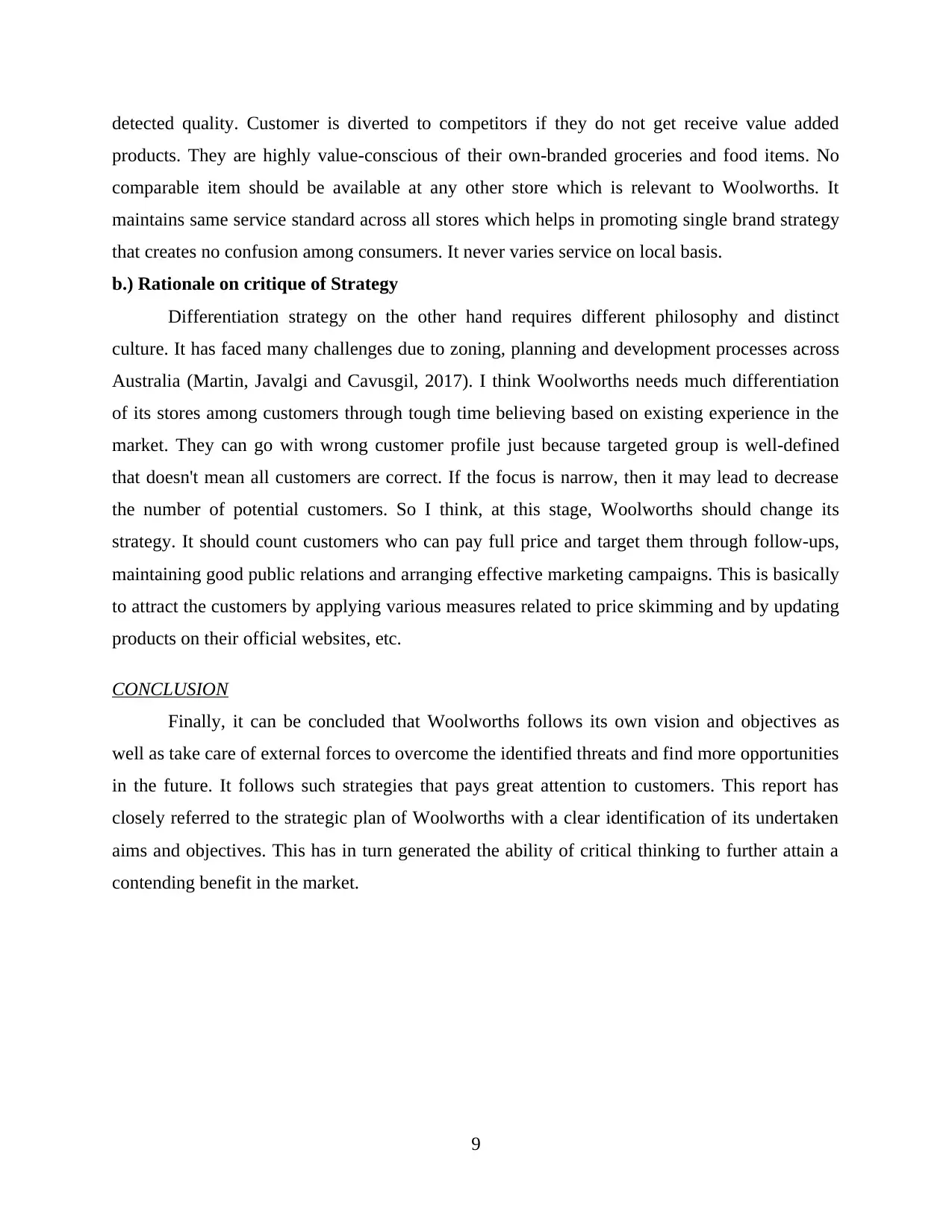
detected quality. Customer is diverted to competitors if they do not get receive value added
products. They are highly value-conscious of their own-branded groceries and food items. No
comparable item should be available at any other store which is relevant to Woolworths. It
maintains same service standard across all stores which helps in promoting single brand strategy
that creates no confusion among consumers. It never varies service on local basis.
b.) Rationale on critique of Strategy
Differentiation strategy on the other hand requires different philosophy and distinct
culture. It has faced many challenges due to zoning, planning and development processes across
Australia (Martin, Javalgi and Cavusgil, 2017). I think Woolworths needs much differentiation
of its stores among customers through tough time believing based on existing experience in the
market. They can go with wrong customer profile just because targeted group is well-defined
that doesn't mean all customers are correct. If the focus is narrow, then it may lead to decrease
the number of potential customers. So I think, at this stage, Woolworths should change its
strategy. It should count customers who can pay full price and target them through follow-ups,
maintaining good public relations and arranging effective marketing campaigns. This is basically
to attract the customers by applying various measures related to price skimming and by updating
products on their official websites, etc.
CONCLUSION
Finally, it can be concluded that Woolworths follows its own vision and objectives as
well as take care of external forces to overcome the identified threats and find more opportunities
in the future. It follows such strategies that pays great attention to customers. This report has
closely referred to the strategic plan of Woolworths with a clear identification of its undertaken
aims and objectives. This has in turn generated the ability of critical thinking to further attain a
contending benefit in the market.
9
products. They are highly value-conscious of their own-branded groceries and food items. No
comparable item should be available at any other store which is relevant to Woolworths. It
maintains same service standard across all stores which helps in promoting single brand strategy
that creates no confusion among consumers. It never varies service on local basis.
b.) Rationale on critique of Strategy
Differentiation strategy on the other hand requires different philosophy and distinct
culture. It has faced many challenges due to zoning, planning and development processes across
Australia (Martin, Javalgi and Cavusgil, 2017). I think Woolworths needs much differentiation
of its stores among customers through tough time believing based on existing experience in the
market. They can go with wrong customer profile just because targeted group is well-defined
that doesn't mean all customers are correct. If the focus is narrow, then it may lead to decrease
the number of potential customers. So I think, at this stage, Woolworths should change its
strategy. It should count customers who can pay full price and target them through follow-ups,
maintaining good public relations and arranging effective marketing campaigns. This is basically
to attract the customers by applying various measures related to price skimming and by updating
products on their official websites, etc.
CONCLUSION
Finally, it can be concluded that Woolworths follows its own vision and objectives as
well as take care of external forces to overcome the identified threats and find more opportunities
in the future. It follows such strategies that pays great attention to customers. This report has
closely referred to the strategic plan of Woolworths with a clear identification of its undertaken
aims and objectives. This has in turn generated the ability of critical thinking to further attain a
contending benefit in the market.
9
⊘ This is a preview!⊘
Do you want full access?
Subscribe today to unlock all pages.

Trusted by 1+ million students worldwide
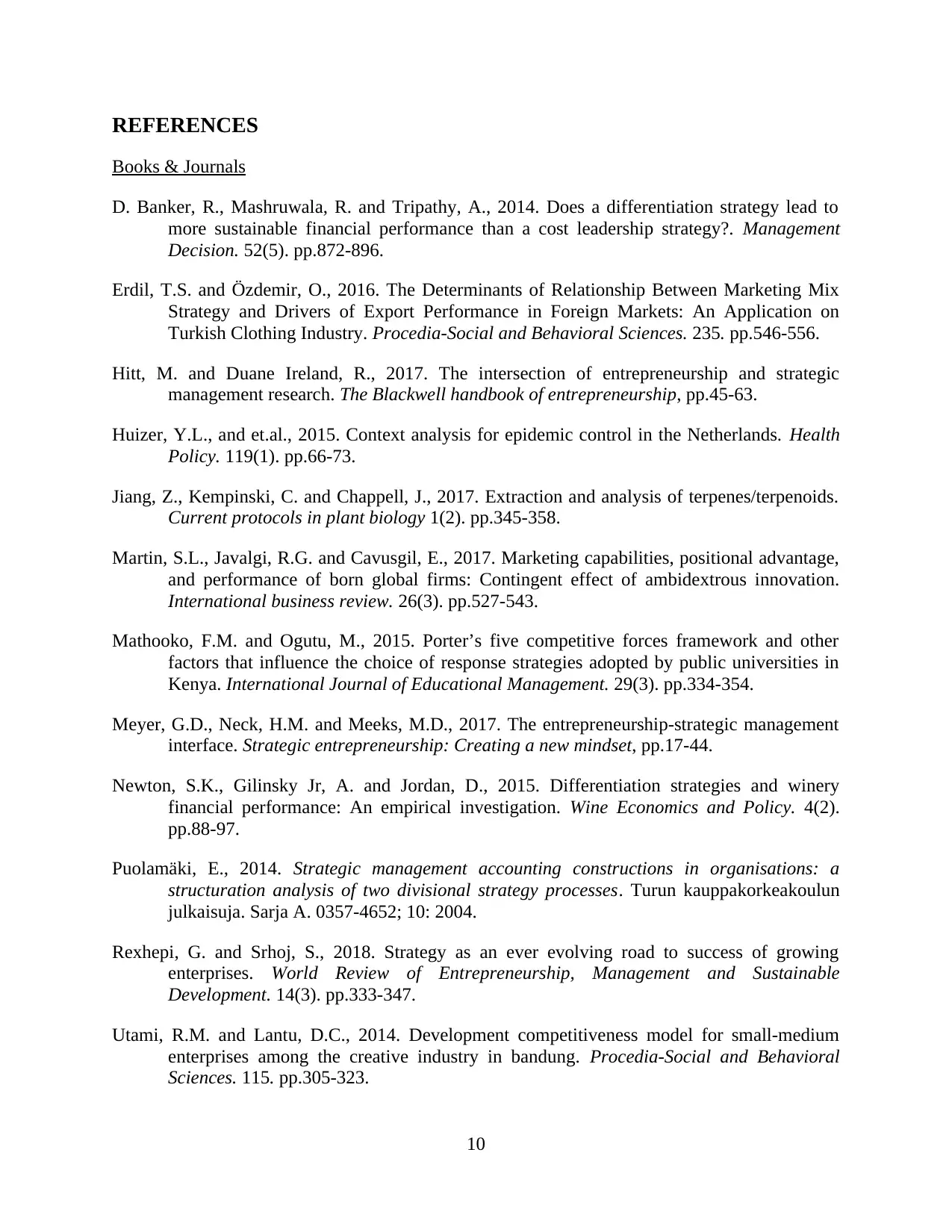
REFERENCES
Books & Journals
D. Banker, R., Mashruwala, R. and Tripathy, A., 2014. Does a differentiation strategy lead to
more sustainable financial performance than a cost leadership strategy?. Management
Decision. 52(5). pp.872-896.
Erdil, T.S. and Özdemir, O., 2016. The Determinants of Relationship Between Marketing Mix
Strategy and Drivers of Export Performance in Foreign Markets: An Application on
Turkish Clothing Industry. Procedia-Social and Behavioral Sciences. 235. pp.546-556.
Hitt, M. and Duane Ireland, R., 2017. The intersection of entrepreneurship and strategic
management research. The Blackwell handbook of entrepreneurship, pp.45-63.
Huizer, Y.L., and et.al., 2015. Context analysis for epidemic control in the Netherlands. Health
Policy. 119(1). pp.66-73.
Jiang, Z., Kempinski, C. and Chappell, J., 2017. Extraction and analysis of terpenes/terpenoids.
Current protocols in plant biology 1(2). pp.345-358.
Martin, S.L., Javalgi, R.G. and Cavusgil, E., 2017. Marketing capabilities, positional advantage,
and performance of born global firms: Contingent effect of ambidextrous innovation.
International business review. 26(3). pp.527-543.
Mathooko, F.M. and Ogutu, M., 2015. Porter’s five competitive forces framework and other
factors that influence the choice of response strategies adopted by public universities in
Kenya. International Journal of Educational Management. 29(3). pp.334-354.
Meyer, G.D., Neck, H.M. and Meeks, M.D., 2017. The entrepreneurship‐strategic management
interface. Strategic entrepreneurship: Creating a new mindset, pp.17-44.
Newton, S.K., Gilinsky Jr, A. and Jordan, D., 2015. Differentiation strategies and winery
financial performance: An empirical investigation. Wine Economics and Policy. 4(2).
pp.88-97.
Puolamäki, E., 2014. Strategic management accounting constructions in organisations: a
structuration analysis of two divisional strategy processes. Turun kauppakorkeakoulun
julkaisuja. Sarja A. 0357-4652; 10: 2004.
Rexhepi, G. and Srhoj, S., 2018. Strategy as an ever evolving road to success of growing
enterprises. World Review of Entrepreneurship, Management and Sustainable
Development. 14(3). pp.333-347.
Utami, R.M. and Lantu, D.C., 2014. Development competitiveness model for small-medium
enterprises among the creative industry in bandung. Procedia-Social and Behavioral
Sciences. 115. pp.305-323.
10
Books & Journals
D. Banker, R., Mashruwala, R. and Tripathy, A., 2014. Does a differentiation strategy lead to
more sustainable financial performance than a cost leadership strategy?. Management
Decision. 52(5). pp.872-896.
Erdil, T.S. and Özdemir, O., 2016. The Determinants of Relationship Between Marketing Mix
Strategy and Drivers of Export Performance in Foreign Markets: An Application on
Turkish Clothing Industry. Procedia-Social and Behavioral Sciences. 235. pp.546-556.
Hitt, M. and Duane Ireland, R., 2017. The intersection of entrepreneurship and strategic
management research. The Blackwell handbook of entrepreneurship, pp.45-63.
Huizer, Y.L., and et.al., 2015. Context analysis for epidemic control in the Netherlands. Health
Policy. 119(1). pp.66-73.
Jiang, Z., Kempinski, C. and Chappell, J., 2017. Extraction and analysis of terpenes/terpenoids.
Current protocols in plant biology 1(2). pp.345-358.
Martin, S.L., Javalgi, R.G. and Cavusgil, E., 2017. Marketing capabilities, positional advantage,
and performance of born global firms: Contingent effect of ambidextrous innovation.
International business review. 26(3). pp.527-543.
Mathooko, F.M. and Ogutu, M., 2015. Porter’s five competitive forces framework and other
factors that influence the choice of response strategies adopted by public universities in
Kenya. International Journal of Educational Management. 29(3). pp.334-354.
Meyer, G.D., Neck, H.M. and Meeks, M.D., 2017. The entrepreneurship‐strategic management
interface. Strategic entrepreneurship: Creating a new mindset, pp.17-44.
Newton, S.K., Gilinsky Jr, A. and Jordan, D., 2015. Differentiation strategies and winery
financial performance: An empirical investigation. Wine Economics and Policy. 4(2).
pp.88-97.
Puolamäki, E., 2014. Strategic management accounting constructions in organisations: a
structuration analysis of two divisional strategy processes. Turun kauppakorkeakoulun
julkaisuja. Sarja A. 0357-4652; 10: 2004.
Rexhepi, G. and Srhoj, S., 2018. Strategy as an ever evolving road to success of growing
enterprises. World Review of Entrepreneurship, Management and Sustainable
Development. 14(3). pp.333-347.
Utami, R.M. and Lantu, D.C., 2014. Development competitiveness model for small-medium
enterprises among the creative industry in bandung. Procedia-Social and Behavioral
Sciences. 115. pp.305-323.
10
Paraphrase This Document
Need a fresh take? Get an instant paraphrase of this document with our AI Paraphraser
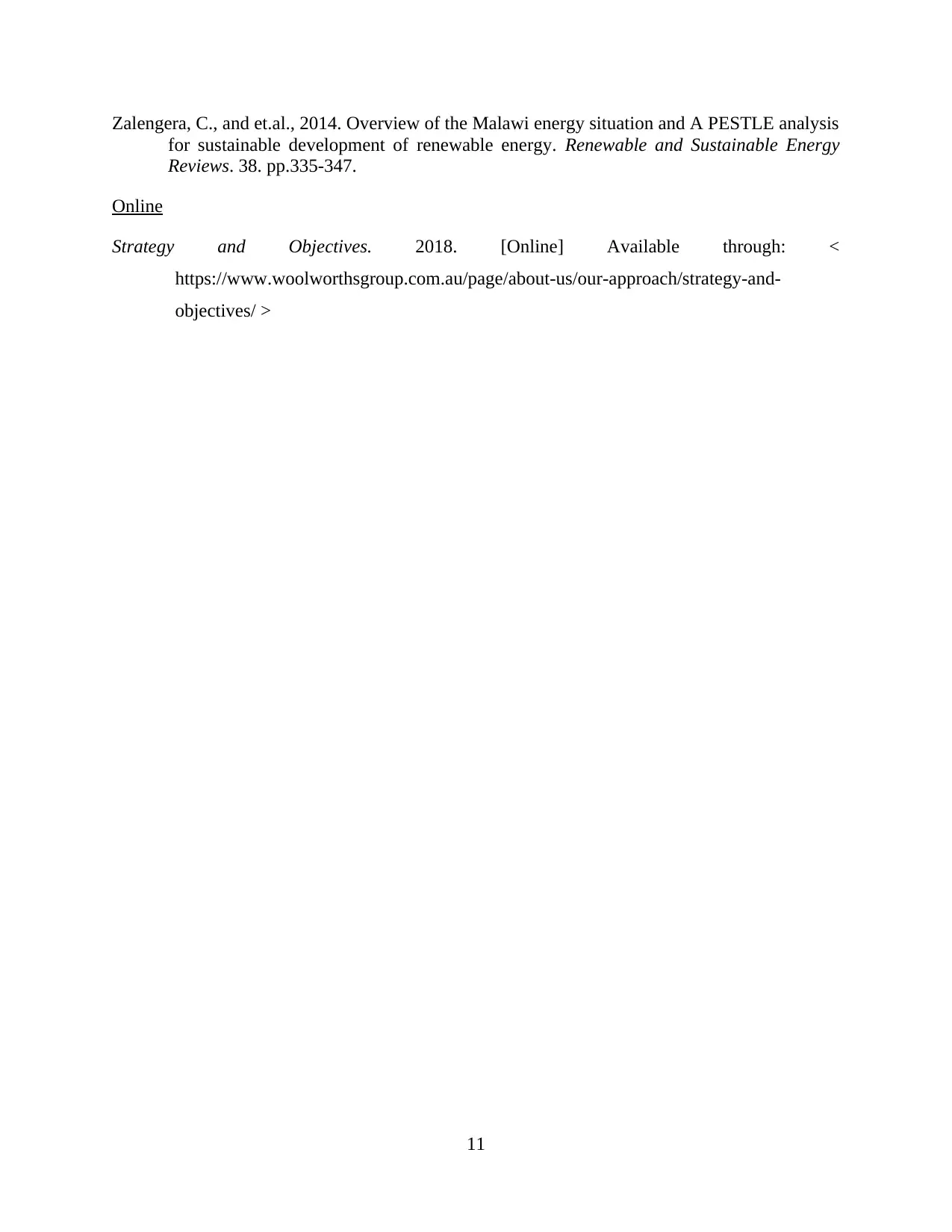
Zalengera, C., and et.al., 2014. Overview of the Malawi energy situation and A PESTLE analysis
for sustainable development of renewable energy. Renewable and Sustainable Energy
Reviews. 38. pp.335-347.
Online
Strategy and Objectives. 2018. [Online] Available through: <
https://www.woolworthsgroup.com.au/page/about-us/our-approach/strategy-and-
objectives/ >
11
for sustainable development of renewable energy. Renewable and Sustainable Energy
Reviews. 38. pp.335-347.
Online
Strategy and Objectives. 2018. [Online] Available through: <
https://www.woolworthsgroup.com.au/page/about-us/our-approach/strategy-and-
objectives/ >
11
1 out of 11
Related Documents
Your All-in-One AI-Powered Toolkit for Academic Success.
+13062052269
info@desklib.com
Available 24*7 on WhatsApp / Email
![[object Object]](/_next/static/media/star-bottom.7253800d.svg)
Unlock your academic potential
Copyright © 2020–2025 A2Z Services. All Rights Reserved. Developed and managed by ZUCOL.





